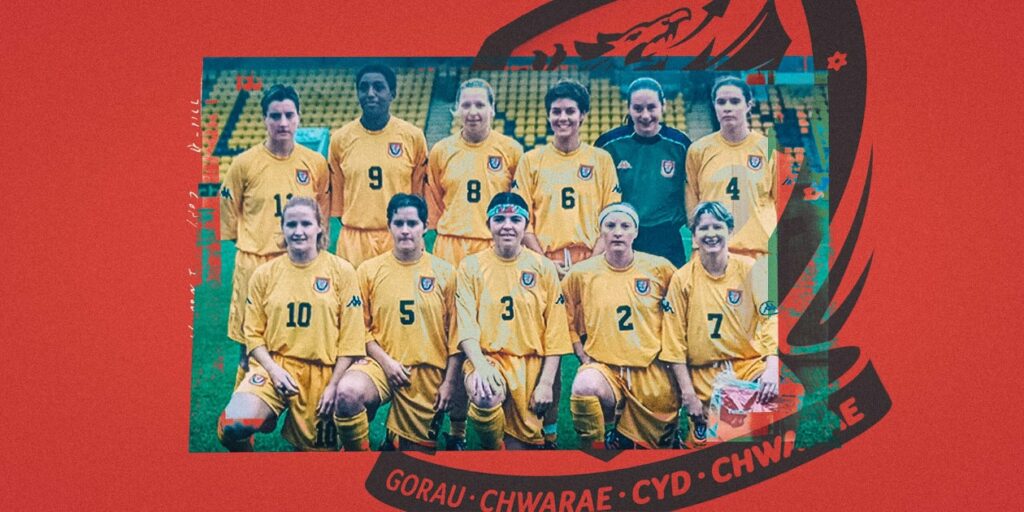Gwennan Harries (No 10), Jess Fishlock (No 16) and Katie Sherwood (No 4) pictured with their Wales Under-19s team-mates (Katie Sherwood)
The meal was the first Harries recalls as being “edible” during the seven-day UEFA mini tournament Wales’ women were playing in.
“This was probably the first time I got really, really angry, a real burning inside,” Harries says. “Because it comes back to this idea of gratitude. We were representing our country. We were meant to be grateful. But we were staying in an army barracks. The councillors refused to stay there, that’s how bad it was. We didn’t see them until the final night of the trip. They were on a holiday, taking their wives out and spending god knows how much on FAW (credit) cards.
“We get one proper meal in a three-game tournament over the course of a week, and we’ve got to say thank you for it? At that point, I knew something still wasn’t right here.”
The memory of Fishlock from that night is at odds with the Fishlock of today: a driving force for women’s football in Wales, unafraid to call out poor standards.
“Today, Jess would be like, ‘First and foremost, we’re not staying at this hotel’,” Harries says of her team-mate, who famously took scissors to an ill-fitting, second-hand, long-sleeved men’s Wales shirt provided by the FAW for a 2009 Euro qualifier in 40C (104F) heat.
“But we saw what they did with the senior team (in 2003). We were afraid that saying anything or making a big hoo-ha would mean they’d do it again. Our role as females was to get on with it. So she ended up saying thank you.”
That same year, Harries and Fishlock made their senior competitive debuts against Moldova in a World Cup qualifier. The occasion was historic for the future, as Fishlock would become the country’s record caps holder (154) and goalscorer (45); but equally for the past, given it marked the official return of the senior women’s national team after more than two years.
But the memory of the team’s removal sat heavy. On the pitch, a near three-year absence from the qualifying stage left an already lagging women’s setup totally adrift of the sport’s leading nations.
“I can remember our first game back,” Harries says. “After a two-year break, we were obviously a sham. We hadn’t trained at all.”
Off the pitch, a sense of helpless gratitude pervaded everything. Adrian Tucker’s appointment as Williams’ replacement in 2006 led to call-ups for uncapped prospects in place of established players, such as ex-captain Claire O’Sullivan, creating discord between the generations.
“Their absences were more along the lines of, ‘These are the troublemakers, leave them out’,” says Ludlow, who retired for a second time after differences with Tucker. “We still weren’t given support, whether that was equipment, staff, facilities, expenses, performances. The culture still wasn’t appropriate, but even if we wanted to raise concerns, who would we raise the concerns with?”
The Athletic contacted the FAW regarding the issues raised in this article but it did not wish to comment.
The fight for equitable support raged for nearly two more decades. Not until 2018 was a first head of women’s football appointed (though the role is currently vacant, and has been since December 2023). Wales’ players did not have their names printed on the backs of their match shirts until 2019, with women-specific kits arriving a year later, while the team continued to train on rented pitches until 2021. Ludlow, who served as first-team manager from 2014 to 2022, also oversaw the under-17s and under-19s, jobs assigned to multiple full-time members of staff on the men’s side.
Progress has come from the sacrifice. More than £10million has been invested into women’s and girls’ football by the FAW in the past five years. Wales’ current number of registered female footballers reaches more than 11,000, doubling figures from 2017. In 2023, equal pay was confirmed for senior national teams. Forty per cent gender balance on the FAW’s board has been pledged for 2027.
This new generation now have the chance to qualify for a European Championship, an opportunity not afforded to those who went before them.
“There was some frightening talent in that era, but they didn’t have the resources to ever achieve what that squad was capable of,” says Sherwood. “They weren’t valued as footballers because it was all to do with money.”
(Top photo: The Wales women’s squad in 2002; design: Eamonn Dalton)
Source link : http://www.bing.com/news/apiclick.aspx?ref=FexRss&aid=&tid=6719cb06c14a461fa817ca1910a0cd1f&url=https%3A%2F%2Fwww.nytimes.com%2Fathletic%2F5866158%2F2024%2F10%2F24%2Fwales-womens-funding-remembered%2F&c=1729623603245215411&mkt=de-de
Author :
Publish date : 2024-10-23 21:14:00
Copyright for syndicated content belongs to the linked Source.
